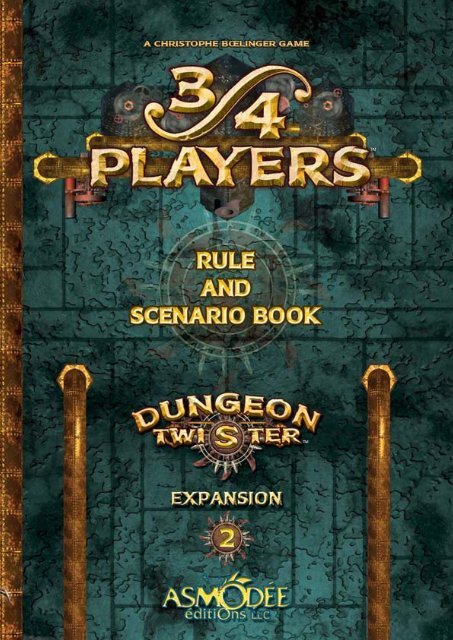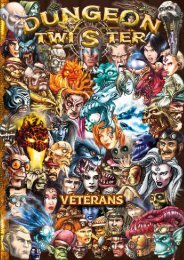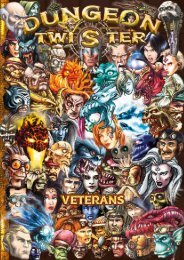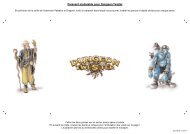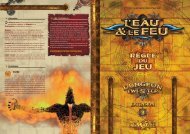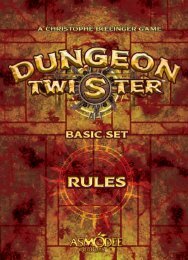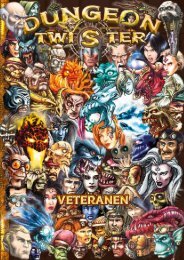Download - Dungeon Twister
Download - Dungeon Twister
Download - Dungeon Twister
You also want an ePaper? Increase the reach of your titles
YUMPU automatically turns print PDFs into web optimized ePapers that Google loves.
TM<br />
TM
Contents:<br />
• 1 book of scenarios<br />
ACTION COMBAT JUMP<br />
BROKEN<br />
2<br />
OPEN<br />
• 8 square rooms<br />
• 2 starting lines (1 per player)<br />
• 2 quick reference screens<br />
• 2 sets of tokens (1 per player) each including<br />
8 characters and 6 objects<br />
• 2 sets of 8 cardboard figurines and 16<br />
plastic bases<br />
• 2 decks of cards (16 cards<br />
per player) each containing 9<br />
Combat cards, 3 Jump cards,<br />
and 4 action cards<br />
• Several “broken” and “open”<br />
Portcullis markers<br />
• Several square markers to keep track of<br />
Actions used during play<br />
• 4 small starting lines in 4<br />
different colors<br />
3 player setup<br />
2 3 3 2<br />
2 3 3<br />
4 player setup<br />
3 3<br />
2 2<br />
3 3<br />
3 4 4<br />
3 4 4<br />
3 3<br />
3 & 4 player rules<br />
2<br />
Number of tokens<br />
per room<br />
Using the contents of both the <strong>Dungeon</strong> <strong>Twister</strong> Basic Set<br />
and this expansion, you can now play <strong>Dungeon</strong> <strong>Twister</strong> with 3<br />
or 4 players.<br />
Rules for 3 and 4 players are identical to the rules for 2<br />
players, with the following modifications:<br />
• Players must score at least 6 VPs to win the game.<br />
• Characters can escape the maze when they reach the starting<br />
line of any opposing player<br />
• The layout of the maze is different. You must choose 6 pairs<br />
of rooms (see diagrams)<br />
• Turns are taken in clockwise order.<br />
• When a player reveals a room, he places all tokens except for<br />
the objects matching his color. These are placed by the player<br />
sitting to his right<br />
• A wounded character may be killed before the next turn of<br />
its controlling player. For example; if a character belonging to<br />
player 3 is wounded during player 1’s turn, it may be killed<br />
during player 2’s turn – that is, before player 3 has a chance<br />
to heal or regenerate it.<br />
• Group combat between characters of more than two different<br />
colors is not allowed.<br />
• To reveal one of the center rooms, a<br />
player must chose one of its sides, lift<br />
the room from the choosen side, and<br />
flip it using this same side.<br />
But that is not all! The 3/4<br />
Players Expansion also offers<br />
many great scenarios for you<br />
to try!<br />
3<br />
3
Background<br />
For his amusement, the Arch-Mage has ordered his<br />
Dwarves and Gnomes to build a huge maze, with a mountain<br />
of objects in the center, and many valiant adventurers<br />
who can only escape across the maze and not through<br />
the sides. The Arch-Mage expects to see some action! He<br />
has designed this maze to prevent anybody from leaving<br />
too quickly. Freedom will be hard-earned!<br />
Expansions Needed<br />
Basic Set and the 3/4 Player Expansion.<br />
3 2<br />
2 3<br />
2 3<br />
3 2<br />
<strong>Dungeon</strong> Map<br />
2 3<br />
3 2<br />
3 2<br />
2 3<br />
4<br />
All the rooms from the base game and the 3/4 Player<br />
Expansion are used. Shuffle the rooms and place them<br />
face down as shown above.<br />
TM<br />
Starting Teams<br />
Each player starts the game<br />
with the 8 characters and 6<br />
objects found in the Basic Set.<br />
Set Up<br />
Each player places 4 face-down character tokens on the<br />
colored dots on his own Starting Line.<br />
Then, in turn, players place their remaining tokens, face<br />
down, in the rooms of the maze. The following guidelines must<br />
be followed when placing tokens in the maze: Rooms with a 2<br />
token limit can only contain face-down characters. Rooms with<br />
a 3 token limit can only contain objects.<br />
Special Rules<br />
If a player has placed the wrong type of token in a room<br />
(for example, she or he placed a face-down character in a room<br />
that can only contain objects,) this token is removed from the<br />
game when the room is revealed. No VPs are earned for it.<br />
How to Win<br />
The first player to score 6 VPs wins this scenario.<br />
Players score 1 VP for each enemy character they eliminate.<br />
Players also score VPs every time one of their characters<br />
manages to exit the maze (1 VP per character, 2 VPs for the<br />
Goblin, 1 VP for the treasure.) However, characters can only<br />
exit the maze through the zone directly across<br />
from their own Starting Line.<br />
3
Background<br />
The Arch-Mage built this maze to remember his own travels<br />
in Pyra-Midys, a land populated by half-man / half-snake creatures<br />
who built gigantic pyramids to honor their gods.<br />
The Arch-Mage’s underground pyramid has a room on its<br />
highest level with a direct access to the surface. It is the only<br />
way to escape the pyramid.<br />
Our adventurers enter the pyramid through the deepest<br />
levels and must fight their way up to reach the highest levels<br />
and freedom.<br />
4<br />
A<br />
4<br />
2 Squares<br />
Expansions Needed<br />
Basic Set and 3/4 Player Expansion.<br />
<strong>Dungeon</strong> Map<br />
Place the room marked with an “A” face down on top of the<br />
pyramid as shown below. Shuffle the remaining 15 rooms and<br />
place them face down as shown below. The colors of each<br />
Starting Lines don't matter in this scenario.<br />
1<br />
2 2 2 2<br />
3 3 3 3 3<br />
3 Squares<br />
2 2 2 2 2 2
Starting Teams<br />
Each player chooses 6 characters from the Basic Set and<br />
takes the 6 objects from the Basic Set.<br />
Set Up<br />
The pyramid consists of 5 levels. The first level is made up of<br />
the Starting Lines. The second level contains 6 rooms. The third<br />
level is composed of 5 rooms. The fourth level has 4 rooms. And<br />
finally the fifth level is only 1 room.<br />
Randomly select which player will be the first player. That<br />
player places one of his characters on any colored dot of any<br />
Starting Line. In a clockwise order, each player does the same on<br />
and empty colored dot.<br />
Continue until each player has placed 3 characters. Thus,<br />
a total of 12 characters are placed on the Starting Lines and<br />
characters of a different colors might be placed on the same<br />
Starting Line. All these characters are placed face down and the<br />
1 st level will be full.<br />
Players then place their remaining characters and objects, face<br />
down, in the rooms of the pyramid. Players must pay attention<br />
to each room’s maximum capacity when placing characters and<br />
objects and must fill up rooms starting with the deeper levels.<br />
Players can only place characters in rooms of the second level.<br />
Once the second level is full, players may start to place tokens<br />
in the third level.<br />
Players can place only objects in rooms of the third, fourth,<br />
and fifth levels.<br />
All levels must be filled in order from the deepest to the<br />
highest, as players place their tokens in turn, until a single object<br />
is placed in the single room of the fifth level.<br />
Special Rules<br />
If a player has placed the wrong type of token in a room (for<br />
example, she or he placed a face down character in a room that<br />
can only contain objects,) this token is removed from the game<br />
when the room is revealed. No VPs is earned for it.<br />
When revealing a room, make sure to follow the original map<br />
of the pyramid when replacing the room face up (see above.)<br />
A character standing on the Starting Line cannot be attacked<br />
(although a fireball may be used to clear the way!). Moreover,<br />
on the Starting Lines, a character can move through an ennemy<br />
character but he cannot stop on it.<br />
How to Win<br />
• The first player to score 4 VPs wins this scenario.<br />
• This scenario may end in a draw if no player can<br />
score 4 VPs.<br />
TM<br />
• Players do not score any VPs for eliminating opposing<br />
characters.<br />
• To exit the maze, a character must reach the room in the<br />
fifth level. Once in the room, this character must activate<br />
the mechanism that will elevate the room to the surface at<br />
the cost of 1 AP. At this point, the room is separated from<br />
the rest of the pyramid. All characters of the active player<br />
that are present in the room may leave the pyramid at the<br />
cost of 1 AP per character. To activate the mechanism, a<br />
character must be standing on the Rotation Gear.<br />
• At the end of that player’s turn, the room is then rotated<br />
one quarter turn in the direction shown by the mechanism.<br />
The room is then reattached to the fourth level as shown on<br />
the map (two squares on the left, three on the right.)<br />
2 Squares<br />
3 Player Version<br />
To play this scenario with 3 players rather than four, make<br />
the following changes:<br />
• Rooms’ maximum capacities are shown in the diagram.<br />
• Rooms in the second level can contain only characters.<br />
• Rooms in the third and fourth levels can contain only objects.<br />
• Each player places 4 characters on the Starting Line during<br />
set up.<br />
0<br />
2 2 2 2<br />
2 2 2 2 2<br />
3 Squares<br />
1 1 1 1 1 1<br />
5
Background<br />
3 teams! A very long labyrinth! 15 characters on a long<br />
Starting Line! Only one exit!<br />
There is no need to spill blood today as the Arch-Mage only<br />
wishes to bet on the fastest team and watch a frantic race!<br />
But that doesn’t mean there won’t be any violence or<br />
trickery…<br />
6<br />
3<br />
Expansions Needed<br />
Basic Set and the 3/4 Player Expansion.<br />
<strong>Dungeon</strong> Map<br />
Shuffle the 14 rooms and place them face down as shown<br />
on the map next page. For this scenario, the colors of the<br />
Starting and Finish Lines don't matter.
Starting Teams<br />
3<br />
3 3<br />
Each player starts the game with the 8 characters and 6<br />
objects from the Basic Set.<br />
Set Up<br />
Randomly select which player will be the first player. Starting with<br />
the first player, each player in turn places one character token face<br />
down on one of the unoccupied colored dots on any Starting Line,<br />
regardless of its color. Proceed as such until each player has placed<br />
5 characters. There should be one empty colored dot left on the<br />
Starting Line at the end of set up.<br />
Players then place their remaining characters and objects, face<br />
down, in the rooms of the labyrinth. The maximum capacity of<br />
tokens per room cannot be exceeded (see dungeon map above).<br />
Rooms marked with a "2" may only contain objects.<br />
Special Rules<br />
If a player has placed the wrong type of token in a<br />
room (for example, she or he placed<br />
a face down character in<br />
a room that can only contain<br />
objects) this token is removed<br />
TM<br />
0 0<br />
0 0<br />
2 2<br />
3 3<br />
3<br />
3 3<br />
from the game when the room is revealed. No VPs is earned<br />
from it.<br />
A character standing on the Starting Line cannot be attacked<br />
(although a fireball may be used to clear the way!). Moreover,<br />
on the Starting Lines, a character can move through an ennemy<br />
character but he cannot stop on it.<br />
How to Win<br />
The game is played through 4 complete cycles of Action<br />
Cards, or 48 total turns.<br />
When the game starts and after the first player has<br />
been choosen, place a token (an Action marker for example)<br />
in front of the third player (who sits to the right of<br />
the first player). Every time the third player recycles his<br />
Action Cards, he places another token in front of him. As<br />
soon as the third player has placed a fifth token in front<br />
of him, the game ends. 4 complete cycles (48 turns) will<br />
have passed.<br />
During the game, players score 1 VP for each character that<br />
exits through one of the small Starting Lines (the finish lines on<br />
top of the maze). The Goblin still scores 2 VPs and the treasure<br />
is worth + 1 VP.<br />
Killing opposing characters does not score any VPs. The<br />
player who has scored the most VPs after 4 complete cycles<br />
wins the game.<br />
7
Background<br />
The Arch-Mage grew a bit bored of all the twisting rooms of<br />
his dungeon. So he asked his Gnomes and Dwarves to build a<br />
brand new kind of deadly maze: one with sliding rooms.<br />
Without delay, the best gnomes and dwarves engineers<br />
got to work on their drafting tables and designed a new<br />
dungeon featuring a room set up on rails. They called it<br />
the “Elevator.”<br />
Three years of hard labor later, the Arch-Mage anxiously<br />
paces the gates of his new toy. He cannot wait to get his hands<br />
on some unfortunate souls. As soon as he can, he teleports a<br />
small number of adventurers into his dungeon and waits for<br />
them to activate the Elevator.<br />
These adventurers are not aware of the dangers that lurk in<br />
the shadows of this new maze, but who cares as long as the<br />
Arch-Mage is happy…<br />
8<br />
3<br />
3<br />
3<br />
3 3<br />
3<br />
3<br />
The Elevator<br />
4<br />
Expansions Needed<br />
Basic Set and the 3/4 Player Expansion.<br />
<strong>Dungeon</strong> Map<br />
3<br />
3 3<br />
3 3<br />
4<br />
The 2 rooms with the rotation mechanism numbered 3 and<br />
the room numbered 1 are placed face down as indicated on the<br />
dungeon map below, each facing in a random direction.<br />
The other rooms are shuffled and randomly placed face-down<br />
on the remaining spots.<br />
All 13 rooms are placed face down.
Starting Teams<br />
Each player starts the game with the 8 characters and 6<br />
objects from the Basic Set.<br />
Set Up<br />
The room numbered 1 is the Elevator. During the set up<br />
phase, players can only place objects in this room. This room has<br />
a maximum capacity of 4 objects.<br />
The rest of the set up phase follows the rules from the Basic<br />
Set; 4 characters are placed on each Starting Line and 3<br />
face-down markers (characters or objects) can be placed<br />
in each room (except the Elevator).<br />
TM<br />
Special Rules<br />
At the cost of 1 AP, a character standing on the Rotation<br />
Gear of the rooms numbered 1 or 3 may move the Elevator<br />
up or down one room. The Elevator room cannot rotate during<br />
this sliding movement. A total of 3 Rotation Gears may activate<br />
the Elevator.<br />
Every room in this scenario, including the Elevator, may<br />
rotate as well.<br />
How to Win<br />
The first player to score 6 VPs wins this scenario.<br />
VPs are scored as explained in the basic rules. But in order<br />
to score points by guiding their characters out of the maze,<br />
the blue player must use the yellow exit, and the yellow player<br />
must use the blue exit. Similarly, the green player must use the<br />
red exit, and the red player must use<br />
the green exit.<br />
9
Background<br />
The Arch-Mage has one twisted mind! He likes nothing more<br />
than devising new ordeals to test the adventurers and creatures<br />
he teleports in his dungeon.<br />
This time, he has built a maze so big and treacherous that<br />
all adventurers will get lost. Even if they were to find an exit, it<br />
probably would not be the right one.<br />
The Arch-Mage has designed this maze so that only one exit<br />
will work for each team he has brought in. Teams will have to<br />
endure many trials before finding themselves in front of a door<br />
they might not even be able to open without being instantly<br />
killed. It all seems so unfair… yet so fun for the Arch-Mage!<br />
10<br />
2 2<br />
2 3 3 2<br />
3 3<br />
3 3<br />
2 3 3 2<br />
2 2<br />
4<br />
Expansions Needed<br />
Basic Set and the 3/4 Player Expansion.<br />
<strong>Dungeon</strong> Map<br />
Every room from the Basic Set and the 3/4 Player Expansion<br />
are used in this scenario. Shuffle all the rooms and place them<br />
face down as indicated below.<br />
Shuffle the small Starting Lines and place them face down<br />
as indicated on the map. These will be revealed at the end of<br />
the set up phase.<br />
For this scenario, the colors of the long Starting Lines<br />
don't matter.<br />
Starting Teams<br />
Each player starts the game with the 8 characters and 6<br />
objects from the Basic Set.
Set Up<br />
Randomly select which player will be the first player.<br />
Starting with the first player, each player places one character<br />
token face down on one of the unoccupied colored dots on any<br />
Starting Line, regardless of its color. Continue until each player<br />
has placed 4 characters.<br />
Thus, a total of 16 characters are placed on the Starting Lines<br />
and characters of different colors might be placed on the same<br />
Starting Line. All these character tokens are placed face down.<br />
Once all 4 long Starting Lines are occupied by 4 characters<br />
and thus are full, players can start placing their characters and<br />
objects (face down) in the different rooms of the maze. The<br />
maximum capacity of each room must be respected.<br />
Once all characters and objects have been placed, the small<br />
Starting Lines are revealed and placed face up. Each player then<br />
reveals his characters on the long Starting Lines.<br />
Special Rules<br />
Characters may move on the Starting Lines regardless of<br />
their color.<br />
A character standing on the Starting Line cannot be attacked<br />
(although a fireball may be used to clear the way!). Moreover,<br />
on the Starting Lines, a character can move through an ennemy<br />
character but he cannot stop on it.<br />
TM<br />
How to Win<br />
The first player to score 5 VPs wins this scenario.<br />
During the game, players score 1 VP for each character that<br />
exits through one of the small Starting Lines of their own color.<br />
The Goblin still scores 2 VPs and the treasure is worth + 1 VP.<br />
Killing opposing characters does not score any VPs.<br />
3 Player Version<br />
This scenario has a 3 player variant that follows all the rules<br />
written above, with the following modifications:<br />
During the initial set up phase, players place 5 characters<br />
instead of 4. One colored dot will remain unoccupied.<br />
The 4 small Starting Lines are still placed face down, but one<br />
of them is nothing but a decoy since it cannot be used by any<br />
of the teams.<br />
The maximum capacity of the rooms is different (see diagram).<br />
One of the rooms will not be full.<br />
2 2<br />
1 2 2 1<br />
2 2<br />
2 2<br />
1 2 2 1<br />
2 2<br />
11
Background<br />
The Arch-Mage has teleported 32 adventurers into his old<br />
dungeon. Left alone in the dark, these adventurers have formed<br />
4 teams.<br />
Earlier today, the Arch-Mage announced that he wanted<br />
to quench his thirst for blood. He's going to watch all these<br />
adventurers kill each other as he remains hidden behind his<br />
magic mirrors. The adventurers fight, maim, and kill to get the<br />
Arch-Mage’s attention.<br />
They have to form alliances to kill the weak and sometimes backstabbing<br />
their former friends is not an option. Friendships only last a<br />
couple of minutes. Only the most ruthless of all will survive!<br />
And the Arch-Mage sits back, relaxes and enjoys the show.<br />
12<br />
2 2<br />
2 4 4 2<br />
2 4 4<br />
2 2<br />
2<br />
4<br />
Expansions Needed<br />
Basic Set and the 3/4 Player Expansion.<br />
<strong>Dungeon</strong> Map<br />
Shuffle all the rooms and place them face down as shown on<br />
the dungeon map.<br />
Starting Teams<br />
Each player starts the game with the 8 characters from the<br />
Basic Set and 4 objects. The Fireball Wand and the Treasure<br />
are removed.<br />
Set Up<br />
Each player places 4 characters face down on his Starting Line.<br />
Then, in turn, players place their characters and objects face<br />
down in the rooms of the maze. The maximum capacity of each<br />
room is indicated on the diagram.<br />
Players can only place objects in the rooms with a capacity<br />
of 2. Players can only place characters in the rooms with a<br />
capacity of 4.<br />
Special Rules<br />
If a player has placed the wrong type of token in a room<br />
(for example, she or he placed a face down character in a<br />
room that can only contain objects) this token is removed<br />
from the game when the room is revealed. No VPs is earned<br />
for it. Players cannot initiate combat before all the<br />
rooms are revealed.
Group Combat with Allies<br />
When a player decides to attack a character on the board,<br />
every character standing on a square adjacent to the attacker<br />
or the targeted character (the defender) may decide to join the<br />
combat, regardless of color.<br />
A combat is always begun between two characters of two different<br />
colors, the attacker and the defender. Characters of a<br />
third or fourth color, standing on a square adjacent to the attacker<br />
or the defender, may or may not join the combat. If a player<br />
decides that several of his characters will join a combat, he must<br />
also declare on which side his characters will fight. They may join<br />
the attacker or the defender’s side.<br />
First, all the players taking part in a combat must place a<br />
Combat Card face down. Then the value of all Combat Cards<br />
is revealed. Finally, both sides add up the total value of all the<br />
Combat Cards. The side with the greatest total wins the combat.<br />
All the characters on the losing side are wounded.<br />
A character standing on a square adjacent to an attacker or a<br />
defender but not participating in the combat is not affected by<br />
the results. However, when a player decides to take side in a combat,<br />
she/he must commit all his characters (except those who are<br />
wounded) that are in contact with the attacker or the defender. A<br />
player cannot commit only some of his characters to a combat.<br />
A player that is the attacker or the defender must commit all his<br />
characters that are in contact with the attacking or the defending<br />
character to the combat (except those who are wounded.)<br />
Every one of the players who win a Group Combat with Allies<br />
scores 1 VP per enemy character wounded or killed.<br />
Example:<br />
Here is an example of a Group Combat with Allies. The<br />
active player is the Red Player. It is his turn. He spends 1 AP<br />
and declares that his Red Warrior attacks the Blue Troll.<br />
The Red Wizard is standing on a diagonal square; he cannot<br />
join the combat (for now.)<br />
Starting with the Red Warrior and the Blue Troll, let’s look at<br />
all the adjacent characters that may participate in the combat.<br />
Since no character is standing near the Red Warrior, we<br />
must start with the Green Warrior and the Green Goblin. They<br />
stand in squares next to the defender (Blue Troll) but not the<br />
attacker (Red Warrior.) They may ally with the Red colored<br />
character, but not with the Blue one. The Green player decides<br />
to take side with the Red player (against the Blue one) because<br />
it is always easy to score points in a collective massacre.<br />
The Yellow Goblin is standing next to the Blue Troll and<br />
next to the Red Wizard. He decides to join the combat and<br />
teams with the Blue side. Because of the Yellow player’s<br />
decision, the Red Wizard now finds himself next to the<br />
combat, which he joins.<br />
If the Green and Yellow players had not joined the combat,<br />
only the Red Warrior and the Blue Troll would have been<br />
involved in the combat. But since the Green player teamed<br />
with the Red player, the Blue Thief now finds herself next<br />
to a player involved in this same Group Combat<br />
with Allies. She has to participate in the<br />
combat, adding her combat valuee<br />
to the Blue Troll's combat value.<br />
As for the yellow Mekanork<br />
he is only adjacent to the<br />
Blue Thief. Since she is an<br />
ally, he cannot participate<br />
in the combat.<br />
TM<br />
In the end, we have:<br />
Red and Green Players against Blue and Yellow Players.<br />
Red Warrior (+3) + Red Wizard (+1) + Green Warrior (+3)<br />
+ Green Goblin (+1) + Red and Green Combat Cards.<br />
Vs.<br />
Blue Troll (+4) + Blue Thief (+2) + Yellow Goblin (+1) +<br />
Blue and Yellow Combat Cards.<br />
Combat Cards are simultaneously played by all players<br />
involved in a combat. Then all Combat Cards are simultaneously<br />
revealed and the combat is resolved. All Combat<br />
Cards are discarded (except the +0 Combat Card).<br />
All characters from the losing side are wounded. Each<br />
player from the winning side receives 1 VP per wounded<br />
enemy character. In our example, if the Red and Green<br />
players had won, they would have scored 3 VPs each. If the<br />
Yellow and Blue players had won, they would have scored<br />
4 VPs each.<br />
How to Win<br />
The first player to score 12 VPs wins this scenario.<br />
Players score 1 VP each time one of their own character<br />
reaches any opponents Starting Line, regardless the color (2<br />
VPs for the Goblin).<br />
Players score 1 VP for each ennemy character they kill or<br />
wound, even if they do so in a Group Combat with allies. Players<br />
score 1 VP when they wound a Troll, even if it regenerates<br />
during the following turn. If the Troll does not regenerate, a<br />
player may kill it and score another VP.<br />
Players should use a piece of paper or other markers to keep<br />
score because there are not enough character<br />
markers to do so.<br />
13
Background<br />
Four parties of 8 characters are teleported to each side of<br />
an oddly-shaped maze.<br />
These 4 teams will be divided into 2 groups that will need to<br />
cooperate in order to reach a common goal.<br />
A total of 32 characters thrown in a narrow labyrinth, but separated<br />
into two teams, one against the other. The problem is that<br />
characters from the same team don't really know each other. They<br />
are not trained to coordinate their actions or to fight together.<br />
Expansions Needed<br />
Basic Set and the 3/4 Player Expansion.<br />
<strong>Dungeon</strong> Map<br />
14<br />
4<br />
4<br />
Shuffle the 10 rooms and place them face down as shown<br />
on the diagram.<br />
4<br />
4<br />
4<br />
4<br />
Starting Teams<br />
Each player starts the game with the 8 characters and 6<br />
objects from the Basic Set.<br />
Set Up<br />
Each player places 4 characters face down on his Starting Line.<br />
Then, players place the rest of their characters and objects<br />
face down in the rooms of the maze. The maximum capacity of<br />
each room is indicated on the diagram.<br />
4 4<br />
4<br />
4<br />
4
Special Rules<br />
When a player reveals a room, he doesn't place his own characters<br />
and objects in the room. It is up to the player seated<br />
across the table from him to do so.<br />
Red and Green are allies. Yellow and Blue are allies.<br />
Allied players may not attack each other.<br />
Characters may pass through a square occupied by a character<br />
belonging to an allied player.<br />
Characters may carry allied wounded characters.<br />
These teams never trained to fight as a single unit. Because of<br />
this, they may not engage in Group Combat with Allies. Combat<br />
may only involve characters from two different colors (for<br />
example, Red vs Blue or Yellow vs Green.)<br />
TM<br />
Optional Rules<br />
To simulate the fact that teams in each group do not know<br />
each other, we advise that you follow this optional rule:<br />
Allied players may not discuss tactics and strategy in any way,<br />
including secret messages or other forms of communication.<br />
However, when a character passes through a square occupied<br />
by an allied character or finishes a move in a square next<br />
to an allied character, the two players may spend one minute<br />
at the end of the turn to discuss strategy. They may not talk<br />
for more than one minute. They may talk in front of the other<br />
two players or in private.<br />
How to Win<br />
• The scores of allied players are added. Allied players win if<br />
they score a total of at least 10 VPs.<br />
15
Object of the Game<br />
• The winner is the first player who earns 5 victory points (VP) or 6 VPs in case of a 3 or 4 players game.<br />
• You earn 1 VP when you eliminate an opposing character.<br />
• You earn 1 VP when one of your characters escapes from the labyrinth.<br />
• The Treasure is worth 1 extra VP is one of your characters escapes from the labyrinth carrying it.<br />
• The Goblin is worth 2 VPs when he escapes from the labyrinth (instead of 1 VP for the other characters).<br />
Order of Play<br />
During his turn, a player must complete the 3 following phases<br />
in the following order:<br />
1. Play an Action card.<br />
2. Use all or some of his Actions.<br />
3. Get all of his Action cards back in hand if he does not have any left.<br />
Using 1 AP allows you to:<br />
• Reveal a room.<br />
• Rotate a room.<br />
• Move a character.<br />
• Initiate combat.<br />
• Use a character’s Special Ability.<br />
• Use an object.<br />
Move a Character<br />
During his movement, a character can:<br />
• Move into any adjacent square (characters can move backwards).<br />
• Move over objects or wounded characters (friendly or enemy)<br />
even stop on objects and friendly wounded characters.<br />
• Move over characters of his own color, but not stop on them.<br />
• Move over or stop on a Rotation Gear.<br />
• Cross over an open or broken Portcullis.<br />
On the other hand, a character cannot:<br />
• Move diagonally.<br />
• Move over or stop on a Pit Trap.<br />
• Move over or stop on an enemy character.<br />
• Cross over a closed Portcullis.<br />
• Pass through a wall.<br />
2nd Golden Rule:<br />
At the end of a character’s movement, he cannot:<br />
• Stand on the same square as an unwounded character (regardless of the character’s color).<br />
• Stand on the same square as a wounded enemy character.<br />
• Stand on a Pit Trap.<br />
• Stand on the same square as two other tokens (regardless of their nature).<br />
There can never be more than two<br />
tokens in the same square at the end of<br />
any action.<br />
• Object must be removed from the game after use.<br />
• Lock-picking.<br />
• Magic User.<br />
• Flying.<br />
• Breaks Portcullis.<br />
• Regeneration.<br />
• Craftsmanship.<br />
• Deactivating<br />
Pit Traps<br />
<strong>Dungeon</strong> <strong>Twister</strong> was created by Christophe Boelinger, edited by Asmodee Editions LLC and illustrated by Eric Bourgier and Thierry Masson. Editing: Eric Franklin.<br />
©2006 ASMODÉE EDITIONS LLC. <strong>Dungeon</strong> <strong>Twister</strong> is a trademark of ASMODÉE ÉDITIONS SAS. Patent pending.<br />
Learn more at www.dungeontwister.com<br />
The author would like to thank the many players who set off on the <strong>Dungeon</strong> <strong>Twister</strong> adventure. This experience has created some<br />
great memories and made a dream come true for some of us . . . And now you won’t have to wait for my prototypes in order to play!<br />
Thank you, all of you and I hope we’ll keep “twisting” the rooms together for many years to come . . . Raphael « Shadow » Puch, Olivier « Red<br />
Dragon » Grassini, Yves « Mekanork » Ley, Phillipe « Télékinésiste » Maurel, Guillaume « No timer » Angousturès, Loic Maitrehut, Croc, Didier Guiserix,<br />
Charly Morelli, Stephane Martin, JJérome<br />
rome et Karine L'hurriec, Anita Teixeira, Bernard Torrès, Benoit Mordelet, Dimitri Locatelli, Cyril Anaya, Monsieur Phal, Jason<br />
Guillamot, Illia Racunica, Matthieu Gitton, Laurent Wozniak, Sylvie Damentko, Laurent Viallard, Daniel Sainz, Christophe Bolognino, Patrice « Uzul » Giorgi, Michel<br />
Léger, François Joubaud, Olivier Lavaud, Jérôme Gayol et L’entre Jeu, Christian Concas, Christian Schriek, Stephane Abello, Nicolas Anton, Lise Ley, Simba et Julie<br />
Valentin, Christophe Peres, Christine Hernandez-Davo, Fabienne Roussel, Bruno Cathala, Eric et Catherine Esiwczak, Laveau Etienne, Fourage Jerôme, Feynas Paul,<br />
Lacurie Geofrey, Simon Lefebvre, Jean Marc et Christine Guicheney, Marc Ladent et Sylvain Brel. Brel<br />
TM<br />
1st Golden Rule:<br />
An action must be fully completed before<br />
starting another one.


